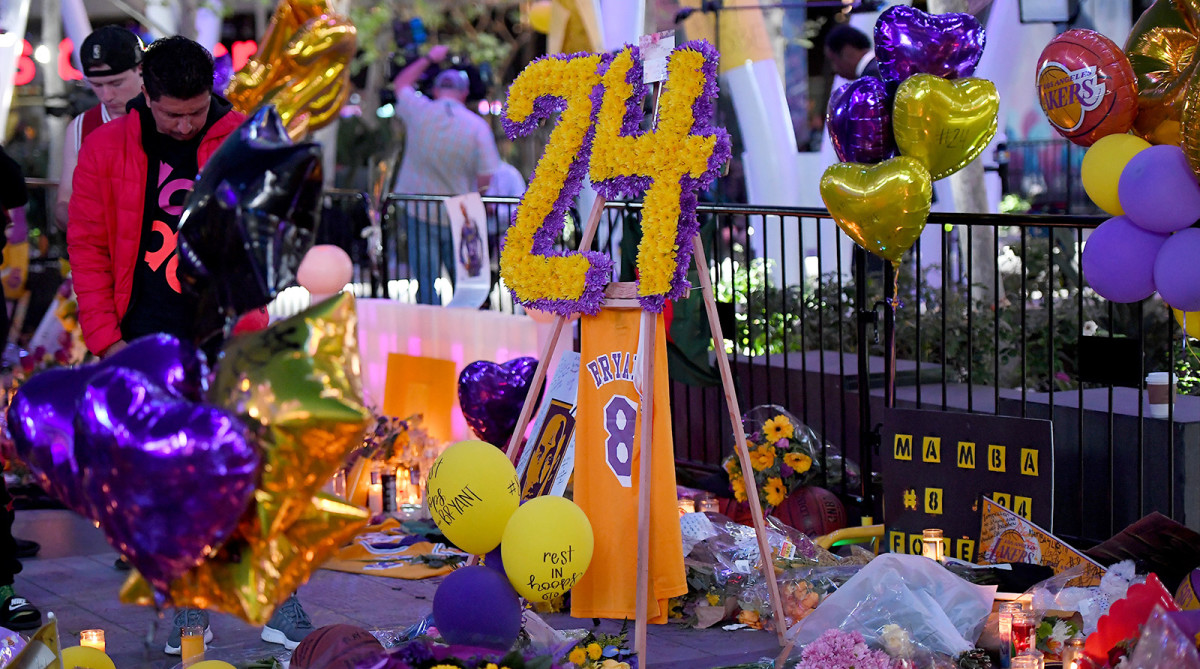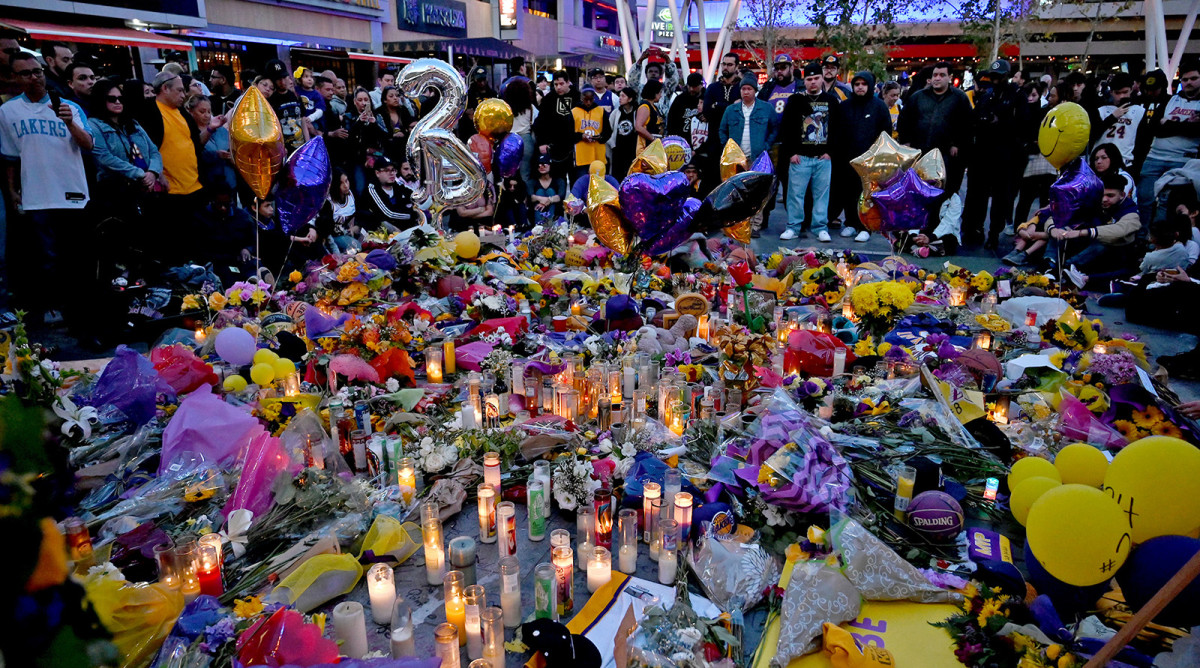Staples Center Was the Epicenter For Those Devastated by Kobe Bryant's Death

Within a week of the fog-shrouded helicopter crash that killed Kobe Bryant, 25,000 candles had been placed on the concrete outside Staples Center, their light flickering upon countless rosaries. A wooded hillside in Calabasas is where Bryant’s life came to a close on Jan. 26, along with the lives of his daughter Gianna and seven others, but the street outside his workplace is where the mourning began.
“People didn’t know where else to go,” says Lee Zeidman, Staples Center’s president, who has been in charge of the arena during its entire two-decade existence.
Zeidman was at work that Sunday morning, overseeing rehearsals for the Grammy Awards that night, when the news of Bryant’s death reached him. “Like the rest of the world, I was shocked,” he says. “Then it became real.”
By nightfall, a few dozen mourners had become 10,000. As the bereaved poured in, Zeidman and his team realized they didn’t have time to hold meetings or devise a plan. “This [memorial] was going to happen with or without us,” he says. “First thing, we decided we’d be respectful. I told our staff, ‘Let them write on the pavement and on our neighbors’ walls. Let them bring whatever they want to bring and leave it wherever they want to leave it. We’ll figure it out later.’ ” Over the next eight days an estimated 300,000 fans staggered through Staples’ downtown campus, leaving behind 1,300 basketballs; 5,000 signs, letters and flags; 1,000 hats; 500 stuffed animals and 350 pairs of shoes.
They were still counting the jerseys.

Security and public safety, Zeidman adds, never became an issue: “They policed themselves. Everyone was respectful. There were no disturbances, no thefts of merchandise or mementos.”
The waves of grief, meanwhile, had quickly rippled outward on that first day, crossing oceans and continents as the sporting world paid tribute to a star of truly international standing. When Neymar, the Brazilian soccer star, scored on a penalty kick for Paris Saint-Germain that evening, he raised two fingers on one hand and four on the other, in recognition of one of Bryant’s Lakers jersey numbers.
Just north of Manila, a Filipino politician cut the ribbon on a Bryant-inspired basketball community center called House of Kobe. Then the news of the tragedy in Calabasas broke. “Everyone has been fighting back tears today,” said Rep. Eric Martinez, the driving force behind the facility.
Word of Bryant’s death flooded Weibo, the Chinese social media monolith on which Bryant claimed 9.2 million followers—he had 15 million Twitter followers from the rest of the world—overtaking the coronavirus outbreak as its top trending item.
Tears flowed in the Italian town of Reggio Emilia, where Bryant spent his formative years, when his former youth club posted a photo of his Cantine Riunite team from the early 1990s, featuring a rail-thin Bryant in the back row. “Per sempre uno di noi,” read the adjoining message. Forever one of us.
Outside Staples crowds lingered until 2 a.m. for the rest of that week as the massive LED images depicting Kobe and 13-year-old Gianna blazed overhead, on surrounding skyscrapers. “Once daylight hit again, at around six,” Zeidman says, “people would start to congregate again and . . . leave flowers, mill around, tell stories, share their pain.”
Kobe Bryant will be remembered first and foremost for his ability to place a ball 29 1/2 inches in circumference through a slightly larger metal ring, but the divisive nature of his career is also among his most persistent legacies. Kobe hating became something of a cottage industry after the millennium turned, as the ultracompetitive Lakers star found his name mentioned with Michael Jordan among the sport’s all-time greats. The public’s desire to dent Bryant’s
all-encompassing belief in himself only intensified when he was charged with sexual assault in 2003. (The criminal case was later dismissed. Bryant paid the woman an undisclosed civil settlement.) Not long after, when LeBron James joined the Greatest of All Time conversation—then joined the Lakers two years after Bryant’s 2016 retirement—Kobe fans could no longer merely be fans. They had to practically adopt him as a family member and be prepared to defend
him accordingly.
There were no half measures where Bryant was concerned—not with his hunger to compete, nor among the devotion of his followers around the world. Thus, there could be no throttle on the grieving after Jan. 26. The throng outside Staples Center spray-painted and Sharpied their dedications to Bryant and his daughter on every available surface, mostly in English, but also in Spanish and Italian, along with the consonant-rich dialects of Eastern Europe and the Balkans. Arabic characters flowed on downtown L.A.’s sidewalks next to Japanese kanji. When there was no room left on the streetlights and storefronts, Zeidman’s team put up 14 white banners that stretched 150 feet. Fans filled those with tributes, too.
“We realized we couldn’t let this go on forever,” Zeidman says of the wake he found himself hosting. Staples Center had contractually obligated events on the calendar, and those events needed space and time to move in. They determined that Super Bowl Sunday, one week after the crash, would be the cutoff. People would be at home watching the game, Zeidman guessed, and he was right.

As the Chiefs and 49ers honored Bryant by standing on their respective 24-yard lines before the kickoff in Miami, Staples Center staffers, contractors and volunteers began discreetly gathering the items that carpeted the grounds outside the arena. Bryant’s widow, Vanessa, had asked that they be passed along to her, so Zeidman and 50 to 70 others met at 4 a.m. that Monday and began the process of separating everything into cargo containers that could be forklifted from place to place.
By 9 a.m., the only thing left was a mound of flowers and plants, enough to fill two containers. Cara Vanderhook, Staples Center’s VP of marketing and communications, told Zeidman what Manchester had done with the flowers that filled the English city in the wake of the terrorist bombing at an Ariana Grande concert in ’17. Staples Center followed that example and began the process of drying the green matter and making mulch that will soon be sprinkled onto nearby vegetation.
Zeidman, whose career has placed him at the center of nine NBA Finals, three Stanley Cup finals, 19 Grammy ceremonies and the 2000 Democratic National Convention, says he has “never experienced anything like what we’ve experienced in the last eight days.” And that was before 50-mph gusts roared through Los Angeles the Monday after the Super Bowl. “At one point we had to stop working because the wind was so fierce,” he says. “Cranes at the project across the street were spinning. . . .
“I’m not a spiritual guy, per se, but when that whipped up, it was almost like Kobe was talking to us, telling us to get this done.” In the end, the materials that were gathered and catalogued filled 37 bins, each holding 40 cubic yards.
New mourners were still arriving. Most of them appeared to be Latinx, the group that Bryant acknowledged (in pitch-perfect Spanish) following his final game as the fans who had given him the strongest support during his somewhat shaky first days as a Laker.
That teenager was already a citizen of the world. Throughout his career Bryant would speak French, midgame, with Spurs guard Tony Parker. He dropped Bosnian curse words on Trail Blazers center Jusuf Nurkic. But he saved his best material for players like Andrea Bargnani and Danilo Gallinari who, like him, were raised in Italy.
Less than a month before the helicopter crash, Bryant and Gianna sat courtside at his old workplace as Mavericks star Luka Doncic prepared to inbound the ball in front of them. The Slovenian heard a whisper behind him, in his native tongue. “I was like, ‘Who’s talking my language?’ ” a smiling Doncic said afterward. “Then I saw Kobe. I was really surprised.”
At various points throughout Bryant’s life, and in the days since his death at age 41, we all have been.
